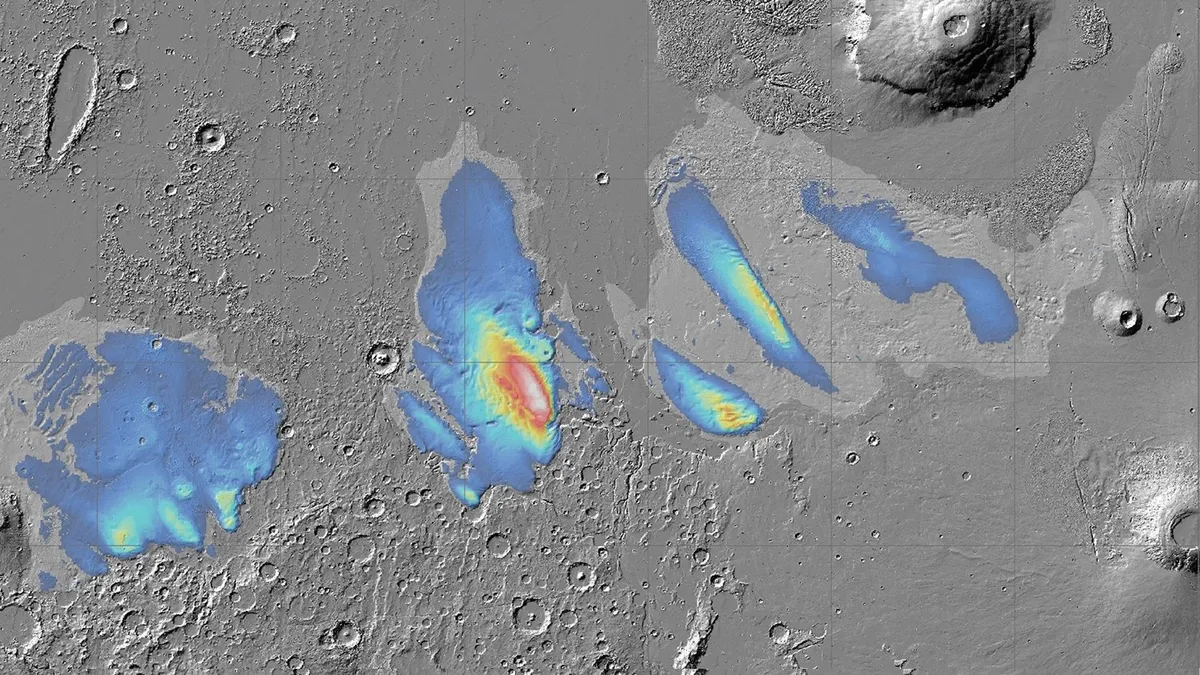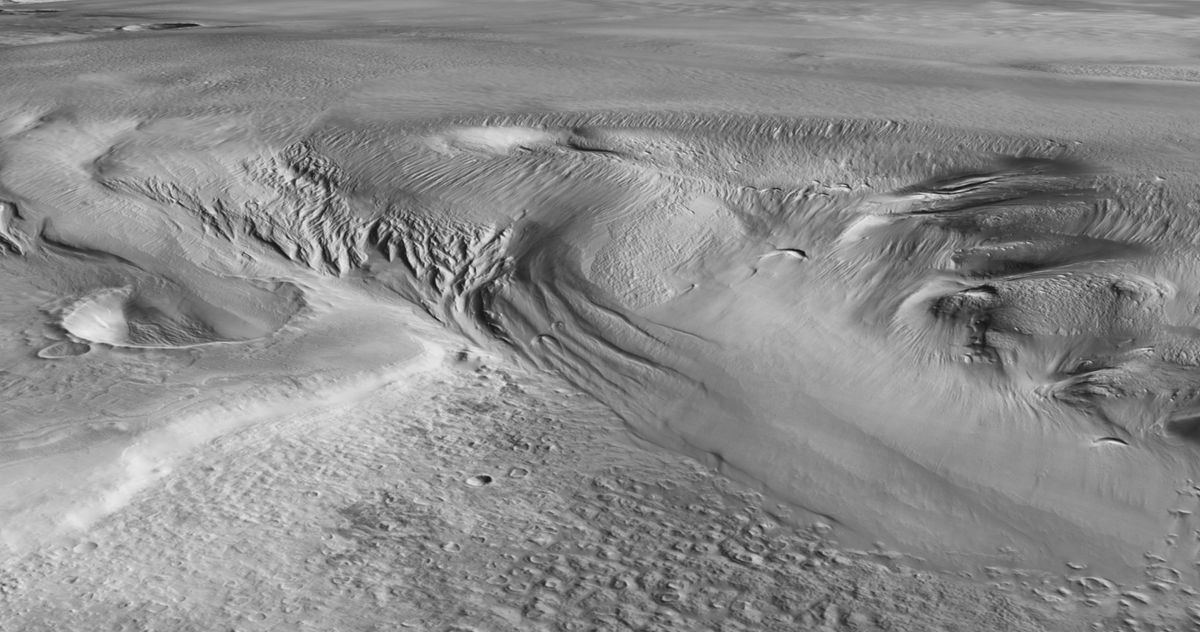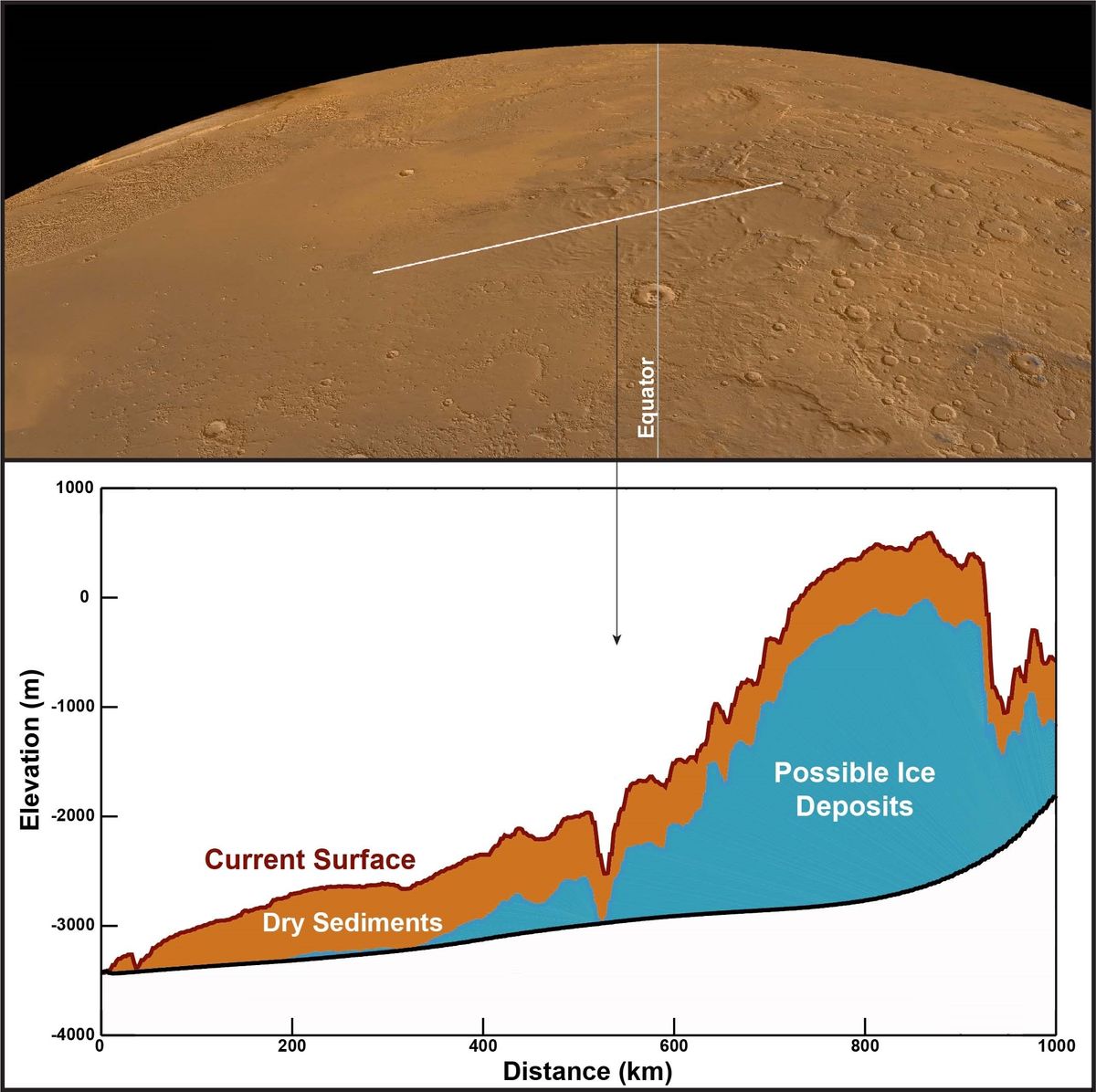Key Takeaways:
- ESA’s Mars Express discovered a massive layer of dusty ice buried under the equator, enough water to cover the entire planet in a shallow ocean.
- The ice is heavily contaminated with dust and is not a pure block. However, its proximity to the equator makes it potentially more accessible for future missions, despite being deeply buried.
- The Medusae Fossae Formation (MFF), previously thought to be just dust, was confirmed to contain this large amount of water ice using radar.
- The discovery adds to evidence of a time when Mars had a much different climate, potentially with more liquid water. The ice’s location at the equator suggests the planet’s tilt may have been much more extreme in the past.
- Scientists are still figuring out how the ice got there and what Martian climate conditions were like in the past.

Found buried beneath the planet’s equator in the form of dusty ice, an ocean between 4.9 and 8.9 feet (1.5 and 2.7 meters) deep is enough water to cover Mars, according to research conducted by the European Space Agency (ESA) probe.
The discovery was made by the Mars Express mission of ESA, an experienced spacecraft that has been conducting research on Mars for the past 20 years. Although there has previously been evidence of ice near the equator of the Red Planet, this new finding is by far the largest amount of water ice found there to date and seems to be consistent with earlier findings of frozen water on Mars.
Lead researcher Thomas Watters of the Smithsonian Institution in the United States said in an ESA statement, “Excitingly, the radar signals match what we expect to see from layered ice and are similar to the signals we see from Mars’ polar caps, which we know to be very ice rich.”
Thick deposits stretch 3.7 km (2.3 mi) below the surface, overlain by a crust of dry dust and hardened ash hundreds of meters thick. The ice is heavily contaminated with dust and is not a pure block. Its proximity to the equator makes it a more accessible location for crewed missions in the future, but its deep burial makes it difficult to access the water-ice.
The composition of the deposits that Mars Express found beneath the Medusae Fossae Formation (MFF), a geological formation, was unknown when it was discovered about 15 years ago. Mars is divided geographically into two regions: the southern lowlands and the northern highlands. The massive 5,000 km-long MMF is located close to the border between the two regions.
The MMF itself is thought to have formed from lava flows within the last three billion years and was covered in volcanic ash during a period of time when Mars was actively volcanic. Today, the MMF is covered in heaps of dust towering several kilometers high — it’s actually the most plentiful source of dust on the entire planet, fuel for the giant dust storms that can engulf Mars on a seasonal basis. Were the deposits just dust, perhaps filling a deep valley?

The answer is now known thanks to new observations made by MARSIS, a subsurface radar on board Mars Express, and it is not dust.
“Given how deep it is, if the MFF was simply a giant pile of dust, we’d expect it to become compacted under its own weight,” said Andrea Cicchetti of the National Institute for Astrophysics in Italy in a press statement. “This would create something far denser than what we actually see with MARSIS.”
Rather, the deposits match the expected appearance of water ice in the data, being low density and relatively transparent to MARSIS’ radar.

z
The question of how the water ice got buried at the equator is more important. Subsurface ice has previously been discovered in large quantities on Mars; in 2008, the lander’s polar landing site was the site of ice discovered by NASA’s Phoenix mission, just below the dusty surface. Meanwhile, early in its mission, Mars Express detected abundant water-ice extending down into the mid-latitudes, and NASA’s Mars Odyssey even found clues to the presence of water in the MMF in 2009.
More recently, ESA’s Trace Gas Orbiter detected hydrogen from water ice just beneath the surface of Candor Chaos, which is a segment of the immense rip in the surface of Mars that we call Vallis Marineris. Not to mention, relict glaciers—ancient glacier remnants—have been observed in Eastern Noctis Labyrinthus, which is only 7.3 degrees south of the equator.
Subsurface water-ice is present at low and equatorial latitudes, suggesting that the climate of Mars was very different a long time ago.
Colin Wilson, an ESA Project Scientist for Mars Express and the Trace Gas Orbiter, said in a statement, “This latest analysis challenges our understanding of the MFF and raises as many questions as answers.” “How long did these ice deposits form, and what was Mars like at the time?”
Mars’s axis of wandering may be the cause of the ice’s existence. It is believed that the axial tilt of the planet’s poles has fluctuated quite erratically throughout the Red Planet’s history. In contrast to Earth, which has an ecliptic tilt of 23 degrees, Mars’ poles are currently tilted to the ecliptic by 25 degrees; however, in the past, this tilt could have varied from as shallow as 10 degrees to as extreme as 60 degrees.
Large amounts of water ice may form on the equator’s surface during high obliquity periods, when the poles point closer to the sun than the equator. After that, the ice might be covered with ash and dust storms and stay that way even now.
The Chinese Zhurong rover’s discovery of 400,000-year-old features on Mars and the presence of gullies formed by liquid water where none should have existed could both be explained by the change in obliquity.
A paper that was published in Geophysical Research Letters describes the new discovery.


